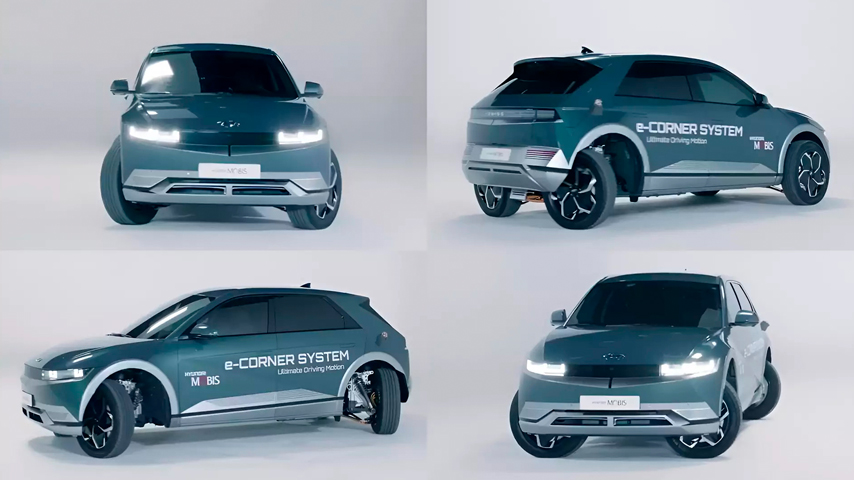Innovative Wheel Technology Allows Cars to Crab-Walk and Pivot-Turn
Innovative Wheel Technology Allows Cars to Crab-Walk and Pivot-Turn


Hyundai Mobis’s e-cornering system uses a package module consisting of brake by wire, steer by wire, damper, and in-wheel motor that is installed on each wheel.
Intricate and congested cityscapes often pose parking and driving challenges. Have you ever wondered how amazing it would be if your vehicle could move sideways into a narrow parking space, or execute an on-the-spot rotation? These capabilities are now here with the design and development of Hyundai Mobis’s e-corner system.
Hyundai Mobis, a leading global automotive supplier in Seoul, Korea, specializes in the development of sophisticated sensors, sensor fusion in electric control units (ECUs), and software development for safety control. The company has spent over a decade developing its e-corner system and continues to advance these technologies (for example, by-wire technology) and features, such as crab walking and the “zero turn.”
In 2023 Hyundai Mobis successfully operated this system using its demonstration vehicle—the IONIQ 5—on public roads for the first time.
Become a Member: How to Join ASME
The e-corner system consists of a module that is installed on each wheel, enabling sophisticated driving maneuvers that cannot be accomplished with a regular vehicle. These driving features include:
The steering system is entirely drive-by-wire, since physically linking the steering wheel to each corner would naturally limit their pivoting abilities. The brakes are engineered to operate independently, enhancing overall safety and control. An improved suspension system absorbs road jolts and shocks, improving the smoothness of the ride. Torque vectoring allows the vehicle to independently modulate the torque delivered to each wheel, which improves stability, especially in hazardous situations where sudden and precise control is required.
“The e-cornering system embodies an evolutionary leap in design, integrating all functional elements necessary for vehicle motion—suspension, steering, braking, driving—within a single wheel through by-wire technology, eliminating the need for mechanical connections,” stated the Hyundai Mobis e-corner engineering team in a recent interview.
More for You: Andreas Wendel on Self-Driving Trucks
For long-wheelbase vehicles, the e-cornering system boosts the range of possible movements significantly. The total gear ratio and the Ackermann steering ratio, key characteristics that define a vehicle's wheel-to-wheel steering, can be customized flexibly via software, based on the individual vehicle's needs, added the Hyundai Mobis team.
The e-cornering system’s versatility is further demonstrated by its adaptability to vehicles of varying weights and power requirements, accommodating four, six, or even eight wheels. Its applicability extends even beyond conventional vehicles, offering potential integration within a broad spectrum of mobility solutions.
“Our main objective during the e-cornering system's development was the integration of all vehicle motion elements—braking, steering, driving, and suspension—within a single module,” said the team. “The formulation of an entirely new concept that still considered the functions of conventional vehicles, all the while architecting a revolutionary system, was our most significant challenge.”
Hyundai Mobis executives said the company is committed to continually enhancing the technical prowess of the e-cornering system to meet future mobility needs. The company’s strategy includes an expansive plan to develop customized mobility solutions suited to autonomous driving and purpose-built vehicles to maintain its global leadership as a mobility platform provider. The company did not provide a timeframe for when the technology will be available.
“Our vision extends further, targeting the development of a robust system that will seamlessly integrate with the mobile aspects of robotics and ground movement functionalities of urban air mobility,” the engineering team added.
Michael Abrams is a technology writer in Westfield, N.J.

Hyundai Mobis, a leading global automotive supplier in Seoul, Korea, specializes in the development of sophisticated sensors, sensor fusion in electric control units (ECUs), and software development for safety control. The company has spent over a decade developing its e-corner system and continues to advance these technologies (for example, by-wire technology) and features, such as crab walking and the “zero turn.”
In 2023 Hyundai Mobis successfully operated this system using its demonstration vehicle—the IONIQ 5—on public roads for the first time.
Become a Member: How to Join ASME
The e-corner system consists of a module that is installed on each wheel, enabling sophisticated driving maneuvers that cannot be accomplished with a regular vehicle. These driving features include:
- Crab-walking—All four wheels turn perpendicular to the curb, allowing the driver to parallel park in a tight space by moving sideways, without needing to back up or turn the steering wheel.
- Diagonal driving—All four wheels turn in the same direction at 45 degrees, helping to avoid obstacles or vehicles on the road.
- Pivot turn—This allows the driver to choose any point for the central axis to rotate the car, where the back wheels turn in opposite directions to swing the rear of the car into position.
- Zero turn—The front wheels rotate inside while the rear wheels turn outside to perform up to a 360-degree idle turn, which allows the driver to easily control the orientation of the vehicle in a limited space, such as a dead end, with minimum movement.
The e-corner system technology allows the vehicle to turn or shift in any direction by precisely controlling how each wheel moves. Key components in the wheels’ package module consist of brake by wire, steer by wire, damper, and in-wheel motor. One module is installed on each wheel. The in-wheel motor handles the suspension, braking, and steering for each corner, eliminating the need for conventional axles, half-shafts, or a steering rack that would otherwise limit the wheels’ overall mobility.
The steering system is entirely drive-by-wire, since physically linking the steering wheel to each corner would naturally limit their pivoting abilities. The brakes are engineered to operate independently, enhancing overall safety and control. An improved suspension system absorbs road jolts and shocks, improving the smoothness of the ride. Torque vectoring allows the vehicle to independently modulate the torque delivered to each wheel, which improves stability, especially in hazardous situations where sudden and precise control is required.
“The e-cornering system embodies an evolutionary leap in design, integrating all functional elements necessary for vehicle motion—suspension, steering, braking, driving—within a single wheel through by-wire technology, eliminating the need for mechanical connections,” stated the Hyundai Mobis e-corner engineering team in a recent interview.
More for You: Andreas Wendel on Self-Driving Trucks
For long-wheelbase vehicles, the e-cornering system boosts the range of possible movements significantly. The total gear ratio and the Ackermann steering ratio, key characteristics that define a vehicle's wheel-to-wheel steering, can be customized flexibly via software, based on the individual vehicle's needs, added the Hyundai Mobis team.
The e-cornering system’s versatility is further demonstrated by its adaptability to vehicles of varying weights and power requirements, accommodating four, six, or even eight wheels. Its applicability extends even beyond conventional vehicles, offering potential integration within a broad spectrum of mobility solutions.
“Our main objective during the e-cornering system's development was the integration of all vehicle motion elements—braking, steering, driving, and suspension—within a single module,” said the team. “The formulation of an entirely new concept that still considered the functions of conventional vehicles, all the while architecting a revolutionary system, was our most significant challenge.”
Hyundai Mobis executives said the company is committed to continually enhancing the technical prowess of the e-cornering system to meet future mobility needs. The company’s strategy includes an expansive plan to develop customized mobility solutions suited to autonomous driving and purpose-built vehicles to maintain its global leadership as a mobility platform provider. The company did not provide a timeframe for when the technology will be available.
“Our vision extends further, targeting the development of a robust system that will seamlessly integrate with the mobile aspects of robotics and ground movement functionalities of urban air mobility,” the engineering team added.
Michael Abrams is a technology writer in Westfield, N.J.

Pulse of the Profession: CAD in 2030
Designers and engineers have been using CAD to add value in innovative ways, in tandem with a wave of Industry 4.0 tech trends, such as additive manufacturing and digital twinning.






